The Value of Trail Corridors for Bold Conservation Planning
Abstract
:1. Introduction
- Do the adjacent landscapes, 1 km on either side, of the Pacific Crest Trail (PCT) and the Continental Divide Trail (CDT) tread hold high wildland conservation value for wildlife corridors? We used spatial data on human modification (or its additive inverse, “wildness”), connectivity, ecosystem representation priority, and biodiversity to evaluate the landscapes surrounding the PCT and CDT. We predicted that the adjacent landscapes (2 km wide to the PCT and CDT tread) would have high conservation value, since both trails were designated for their aesthetic and scenic value. We expected some values like wildness to be high along the trails. However, no one has quantitatively assessed the national wildland conservation value of these lands.
- How much of the adjacent landscapes, 1 km on either side, of the PCT and CDT tread occurs on protected land and who manages it? We also evaluated the current conservation and management status of the adjacent landscapes (2 km wide) to the PCT and CDT. Identifying adjacent landscapes with high conservation values (from question 1) that are under-protected could aid in conservation planning of a wildlife corridor along the PCT and CDT.
2. Materials and Methods
2.1. Question 1
2.2. Question 2
3. Results
3.1. Question 1
3.2. Question 2
4. Discussion
5. Conclusions
Supplementary Materials
Author Contributions
Funding
Data Availability Statement
Acknowledgments
Conflicts of Interest
References
- McGuire, J.L.; Lawler, J.J.; McRae, B.H.; Nuñez, T.A.; Theobald, D.M. Achieving climate connectivity in a fragmented landscape. Proc. Natl. Acad. Sci. USA 2016, 113, 7195–7200. [Google Scholar] [CrossRef] [Green Version]
- Martinuzzi, S.; Radeloff, V.C.; Joppa, L.N.; Hamilton, C.M.; Helmers, D.P.; Plantinga, A.J.; Lewis, D.J. Scenarios of future land use change around United States’ protected areas. Biol. Conserv. 2015, 184, 446–455. [Google Scholar] [CrossRef]
- Hilty, J.A.; Lidicker, W.Z.; Merenlender, A.M. Corridor Ecology: The Science and Practice of Linking Landscapes for Biodiversity Conservation, 1st ed.; Island Press: Washington, DC, USA, 2006. [Google Scholar]
- Anderson, M.G.; Barnett, A.; Clark, M.; Sheldon, A.O.; Prince, J.; Vickery, B. Resilient and Connected Landscapes for Terrestrial Conservation; The Nature Conservancy: Boston, MA, USA, 2016. [Google Scholar]
- Belote, R.T.; Dietz, M.S.; McRae, B.H.; Theobald, D.M.; McClure, M.L.; Hugh Irwin, G.; McKinley, P.S.; Gage, J.A.; Aplet, G.H. Identifying corridors among large protected areas in the United States. PLoS ONE 2016, 11, e0154223. [Google Scholar] [CrossRef] [PubMed] [Green Version]
- Alagador, D.; Cerdeira, J.O.; Araújo, M.B. Climate change, species range shifts and dispersal corridors: An evaluation of spatial conservation models. Methods Ecol. Evol. 2016, 7, 853–866. [Google Scholar] [CrossRef] [Green Version]
- Bond, M. Principles of Wildlife Corridor Design; Center for Biological Diversity: Tucson, AZ, USA, 2003; pp. 1–4. [Google Scholar]
- Aycrigg, J.L.; Davidson, A.; Svancara, L.K.; Gergely, K.J.; McKerrow, A.; Scott, J.M. Representation of Ecological Systems within the Protected Areas Network of the Continental United States. PLoS ONE 2013, 8, e54689. [Google Scholar] [CrossRef] [Green Version]
- Fábos, J.G.; Ryan, R.L. An introduction to greenway planning around the world. Landsc. Urban Plan. 2006, 76, 1–6. [Google Scholar] [CrossRef]
- Williams, J.C.; ReVelle, C.S.; Levin, S.A. Spatial attributes and reserve design models: A review. Environ. Model. Assess. 2005, 10, 163–181. [Google Scholar] [CrossRef]
- Emmanuel, R.; Loconsole, A. Green infrastructure as an adaptation approach to tackling urban overheating in the Glasgow Clyde Valley Region, UK. Landsc. Urban Plan. 2015, 138, 71–86. [Google Scholar] [CrossRef] [Green Version]
- Foster, J.; Lowe, A.; Winkelman, S. The Value of Green Infrastructure for Urban Climate Adaptation; Center for Clean Air Policy: Washington, DA, USA, 2011. [Google Scholar]
- Elkinton, S. The National Trails System: A Grand Experiment; Forgotten Books: London, UK, 2012; p. 50. [Google Scholar]
- Service, U.F. Criteria for Location, Design, Signing and User Facilities. Available online: https://www.wbdg.org/ffc/dod/unified-facilities-criteria-ufc/ufc-3-120-012011 (accessed on 20 February 2019).
- Hendricks, L. No Title. 2021. [Google Scholar]
- Beier, P. A rule of thumb for widths of conservation corridors. Conserv. Biol. 2019, 33, 976–978. [Google Scholar] [CrossRef]
- Pacific Crest Trail Association. Strategic Plan 2018–2021. 2018. Available online: https://www.unwomen.org/en/executive-board/documents/strategic-plan-2018-2021 (accessed on 20 February 2019).
- Kahn, P. No Title. 2018. [Google Scholar]
- Mann, B.S. Where does Pacific Crest Trail Begin? Is it Campo? Manning Park. 2011; 9–10.
- Shaeffer, E. Walking with Spring; Appalachian Trail Conservancy, Appalachian Trail Conservancy: Harpers Ferry, WV, USA, 2004. [Google Scholar]
- Theobald, D.M.; Gross, J.E.; Piekielek, N.; Olliff, T.; Davis, C.; Monahan, W.B.; Haas, J.; Hansen, A.J.; Running, S.W. Exposure of U.S. National Parks to land use and climate change 1900–2100. Ecol. Appl. 2013, 24, 484–502. [Google Scholar] [CrossRef]
- Jenkins, C.N.; Van Houtan, K.S.; Pimm, S.L.; Sexton, J.O. US protected lands mismatch biodiversity priorities. Proc. Natl. Acad. Sci. USA 2015, 112, 5081–5086. [Google Scholar] [CrossRef] [PubMed] [Green Version]
- Venter, O.; Sanderson, E.W.; Magrach, A.; Allan, J.R.; Beher, J.; Jones, K.R.; Possingham, H.P.; Laurance, W.F.; Wood, P.; Fekete, B.M.; et al. Sixteen years of change in the global terrestrial human footprint and implications for biodiversity conservation. Nat. Commun. 2016, 7, 12558. [Google Scholar] [CrossRef] [PubMed] [Green Version]
- Carroll, C.; Parks, S.A.; Dobrowski, S.Z.; Roberts, D.R. Climatic, topographic, and anthropogenic factors determine connectivity between current and future climate analogs in North America. Glob. Chang. Biol. 2018, 24, 5318–5331. [Google Scholar] [CrossRef] [PubMed] [Green Version]
- McKerrow, A.J.; Tarr, N.M.; Rubino, M.J.; Williams, S.G. Patterns of species richness hotspots and estimates of their protection are sensitive to spatial resolution. Divers. Distrib. 2018, 24, 1464–1477. [Google Scholar] [CrossRef] [Green Version]
- Belote, R.T.; Dietz, M.S.; Jenkins, C.N.; McKinley, P.S.; Irwin, G.H.; Fullman, T.J.; Leppi, J.C.; Aplet, G.H. Wild, connected, and diverse: Building a more resilient system of protected areas. Ecol. Appl. 2017, 27, 1050–1056. [Google Scholar] [CrossRef]
- Venter, O.; Sanderson, E.W.; Magrach, A.; Allan, J.R.; Beher, J.; Jones, K.R.; Possingham, H.P.; Laurance, W.F.; Wood, P.; Fekete, B.M.; et al. Global terrestrial Human Footprint maps for 1993 and 2009. Sci. Data 2016, 3, 160067. [Google Scholar] [CrossRef] [Green Version]
- Majka, D. Migrations in Motion. Available online: http://maps.tnc.org/migrations-in-motion/#4/19.00/-78.00 (accessed on 20 February 2019).
- Larson, C.L.; Reed, S.E.; Merenlender, A.M.; Crooks, K.R. Effects of Recreation on Animals Revealed as Widespread through a Global Systematic Review. PloS ONE 2016, 11, e0167259. [Google Scholar] [CrossRef] [Green Version]
- Bisharat, A. National Geographic. 2017. Available online: https://www.nationalgeographic.co.uk/author/andrew-bisharat (accessed on 20 February 2019).
- Brewer, R. Conservancy: The Land Trust Movement in America; Dartmouth College Press: Chicago, IL, USA, 2004. [Google Scholar]
- Wilson, E.O. Half-Earth: Our Planet’s Fight for Life; Liveright Publishing Corporation: New York, NY, USA, 2016. [Google Scholar]
- Dinerstein, E.; Vynne, C.; Sala, E.; Joshi, A.R.; Fernando, S.; Lovejoy, T.E.; Mayorga, J.; Olson, D.; Asner, G.P.; Baillie, J.E.M.; et al. A Global Deal for Nature: Guiding principles, milestones, and targets. Sci. Adv. 2019, 5, eaaw2869. [Google Scholar] [CrossRef] [Green Version]
- Bui, Q.; Sanger-Katz, M. Why the Government Owns So Much Land in the West. New York Times. p. 2016. Available online: https://www.nytimes.com/2016/01/06/upshot/why-the-government-owns-so-much-land-in-the-west.html (accessed on 20 February 2019).
- Newmark, W.D. Western North American National Parks Norte América. Conserv. Biol. 1995, 9, 3–6. [Google Scholar] [CrossRef]
- Calvo Buendia, E.; Guendehou, S.; Limmeechokchai, B.; Pipatti, R.; Rojas, Y.; Sturgiss, R.; Tanabe, K.; Wirth, T.; Romano, D.; Witi, J.; et al. 2019 Refinement to the 2006 IPCC Guidelines for National Greenhouse Gas Inventories; IPCC: Geneva, Switzerland, 2019; pp. 1–15. [Google Scholar]
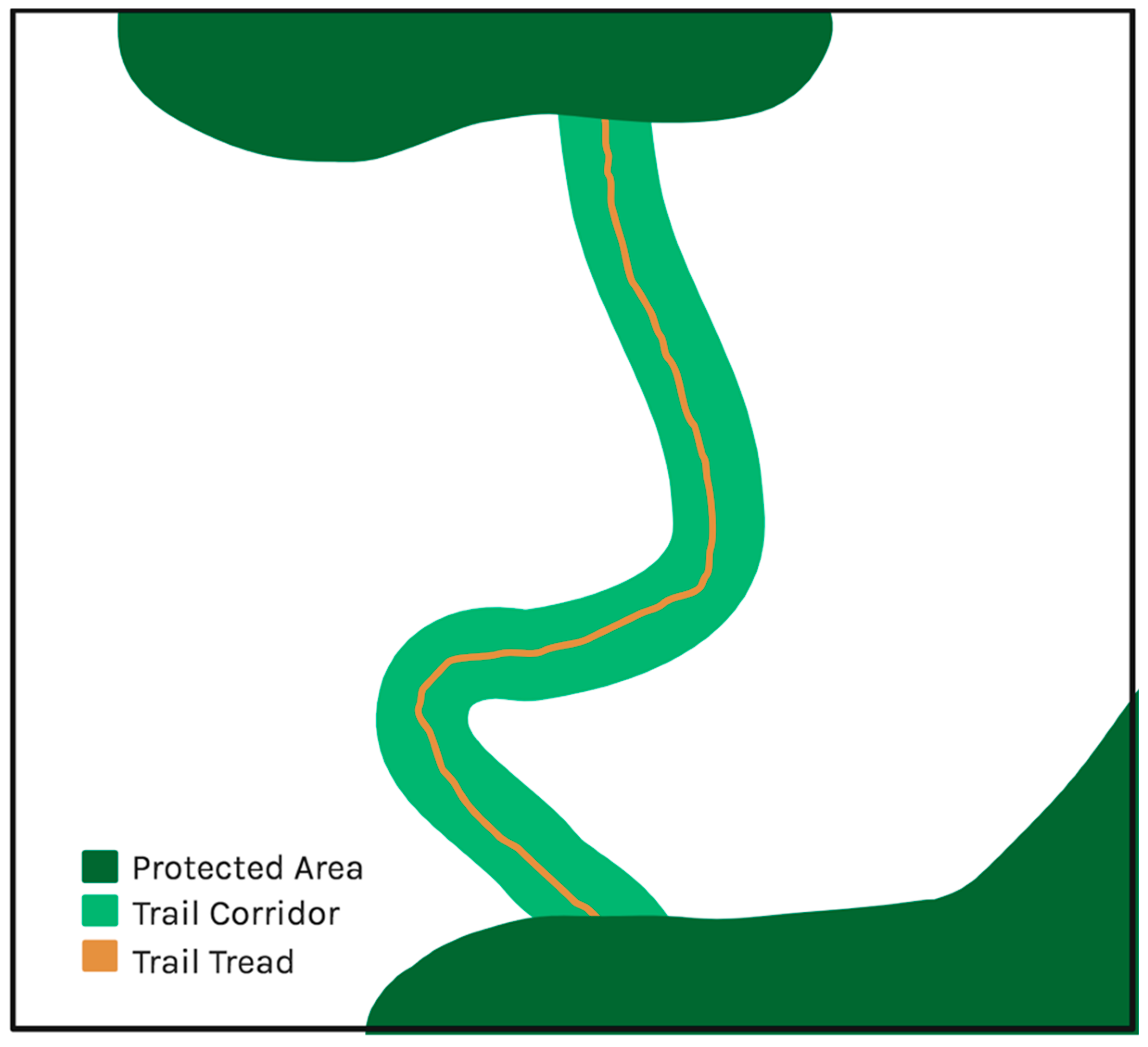
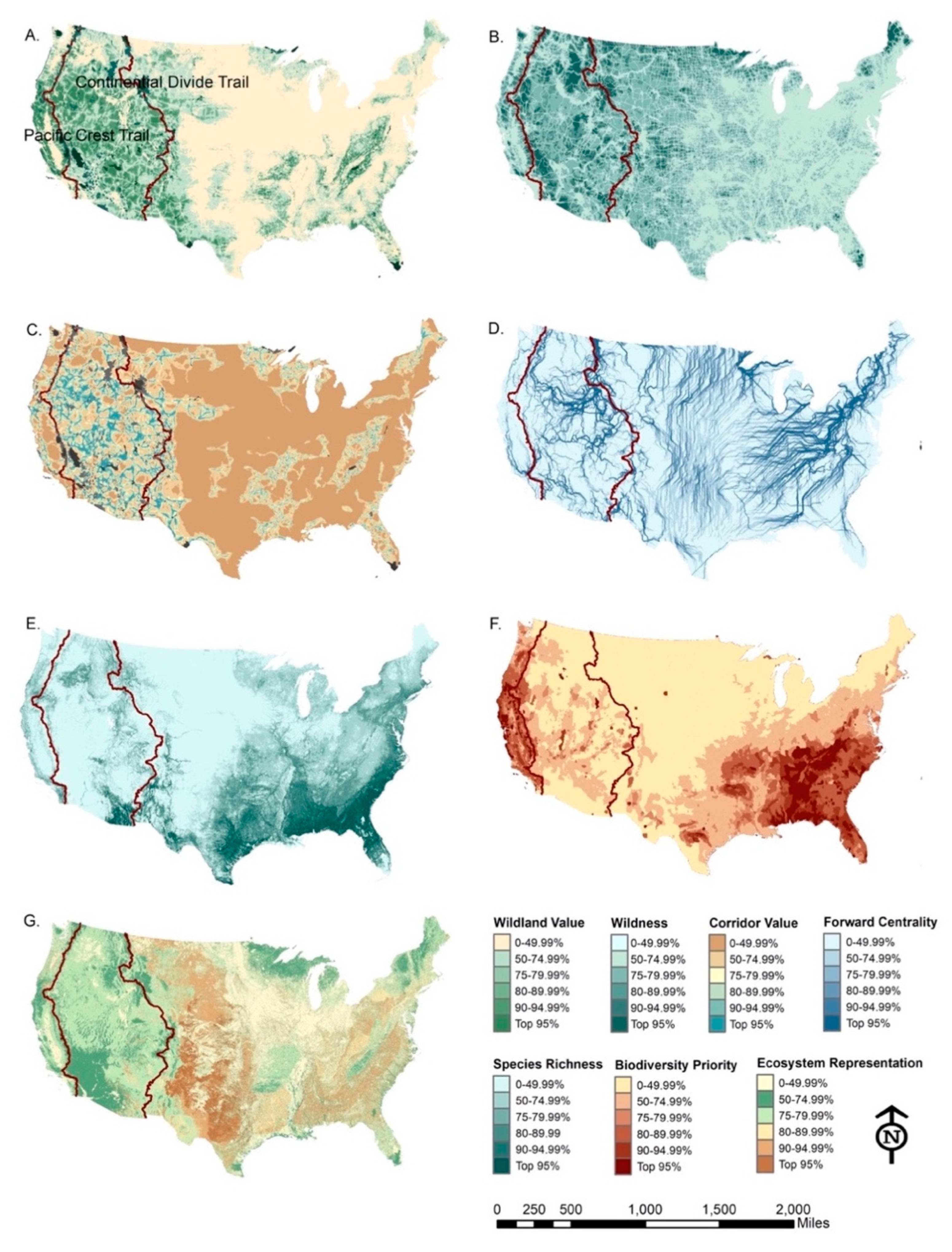

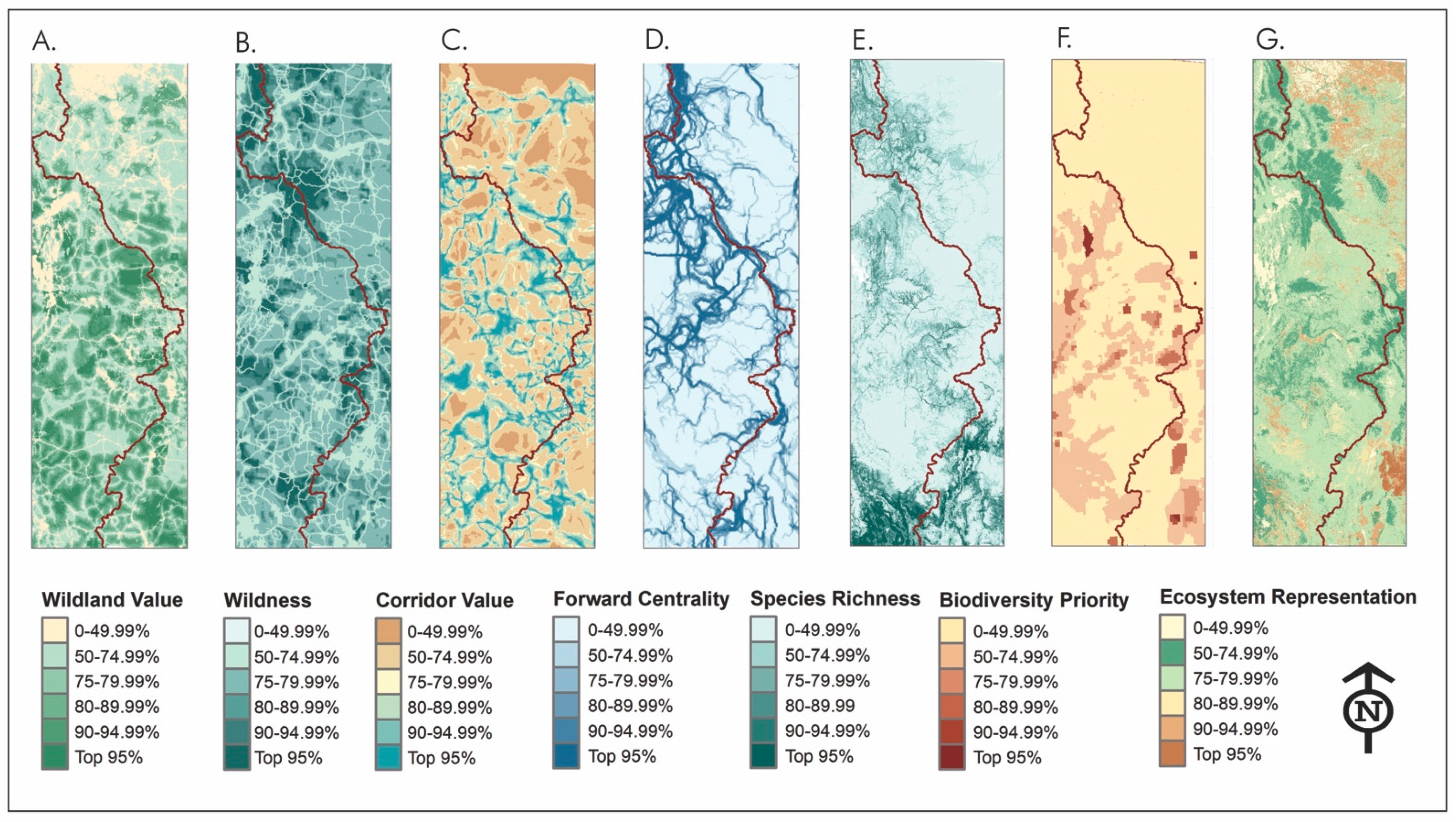
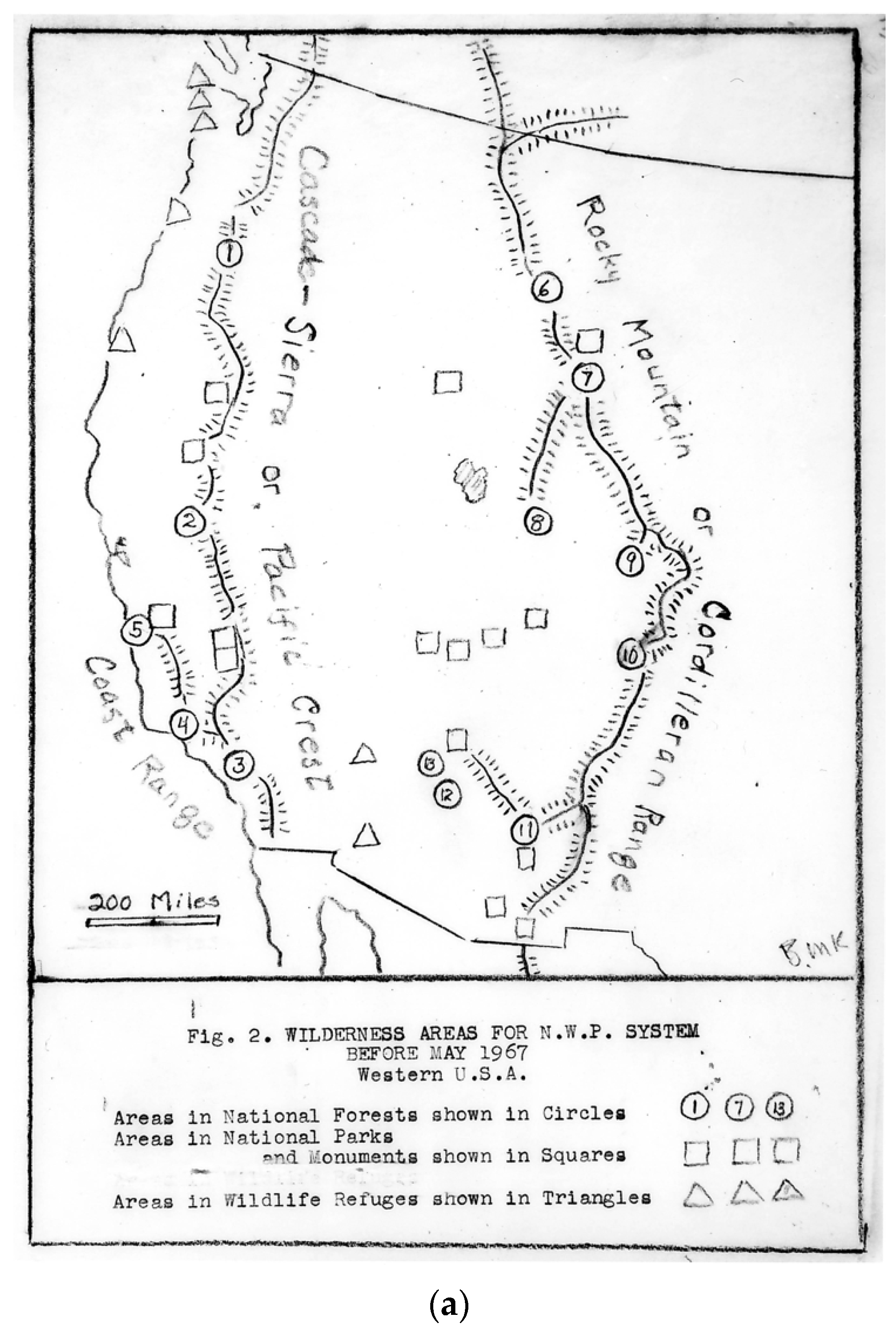
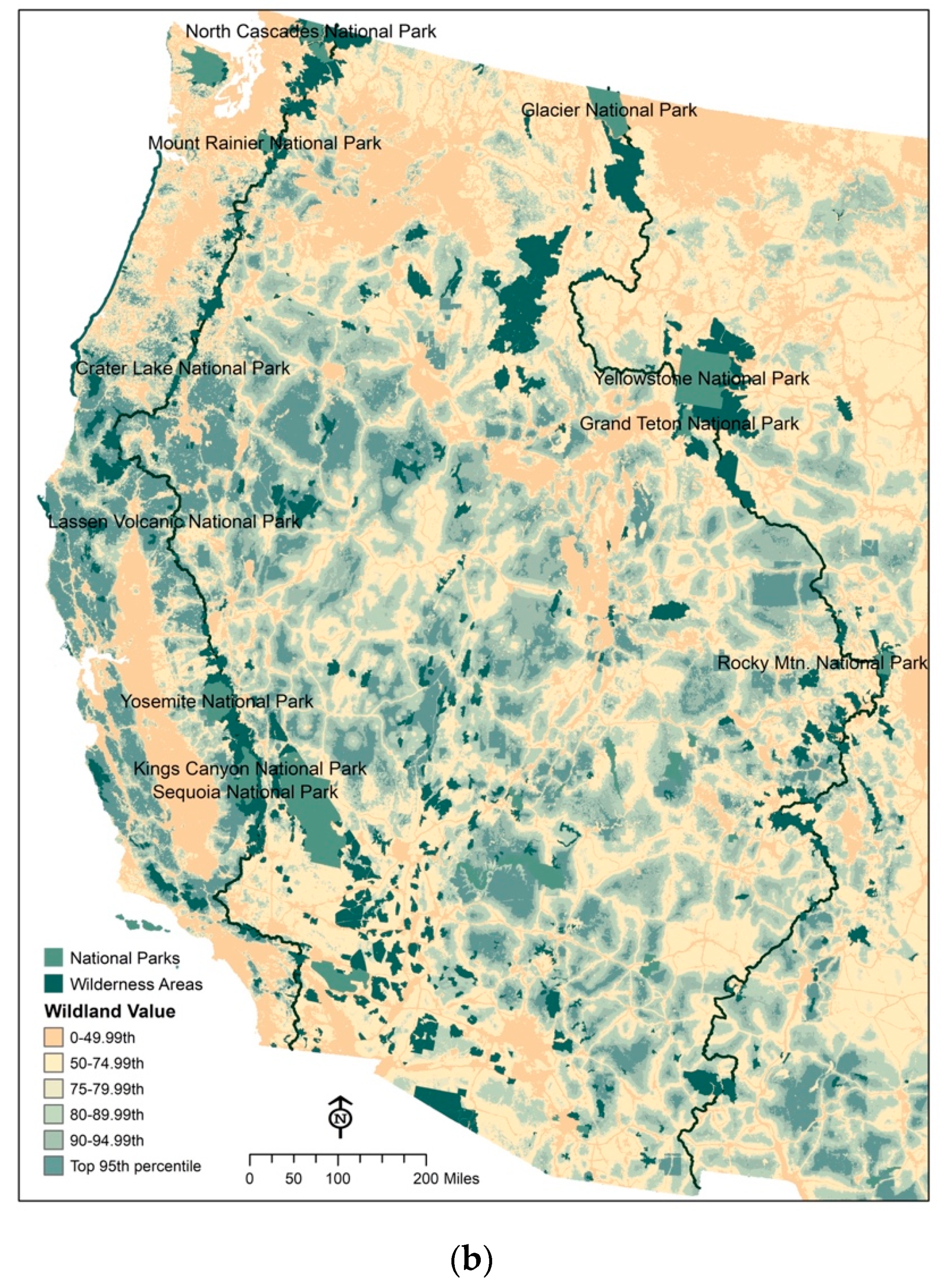
| Data | Source | Website |
|---|---|---|
| Protected Area Database | ||
| PADUS Gap Status | USGS Gap Analysis Program | https://www.usgs.gov/core-science-systems/science-analytics-and-synthesis/gap/science/protected-areas (accessed on 20 February 2019) |
| National Scenic and Historic Trails | ||
| Pacific Crest Trail | Pacific Crest Trail Association, 2015 | https://nps.maps.arcgis.com/home/item.html?id=4d59fc03928a4b07b83c84d823321f34 (accessed on 20 February 2019) |
| Continental Divide Scenic Trail | National Park Service, 2017 | https://nps.maps.arcgis.com/home/item.html?id=908e9a2442bb4da48a4d979d98e02902 (accessed on 20 February 2019) |
| Wildland Conservation Value | Belote et al., 2017 | https://doi.org/10.1002/eap.1527 (accessed on 20 February 2019) |
| Wild | ||
| Human Footprint Database | Venter et al., 2016 | https://doi.org/10.1038/ncomms12558 (accessed on 20 February 2019) |
| Connected | ||
| Corridor Value | Belote et al., 2016 | https://doi.org/10.1371/journal.pone.0154223 (accessed on 20 February 2019) |
| Forward Climate Velocity Shortest Path Centrality | Carroll et al., 2018 | https://doi.org/10.1111/gcb.14373 (accessed on 20 February 2019) |
| Diverse | ||
| Gap Species Richness | McKerrow et al., 2018 | https://doi.org/10.1111/ddi.12779 (accessed on 20 February 2019), |
| Biodiversity Priority | Jenkins et al., 2015 | https://doi.org/10.1073/pnas.1418034112 (accessed on 20 February 2019), |
| Ecosystem Representation | Aycrigg et al., 2014 | https://doi.org/10.5849/jof.15-050 (accessed on 20 February 2019) |
| Wild, Connected, and Diverse | Top 50% | Top 25% | Top 20% | Top 10% | Top 5% |
|---|---|---|---|---|---|
| Wildland Conservation Value | |||||
| Square km | 6123 | 3490 | 2968 | 1939 | 1308 |
| Percentage | 86.74% | 49.44% | 42.05% | 27.47% | 18.53% |
| Wildness | |||||
| Square km | 5448 | 4530 | 4015 | 2747 | 1600 |
| Percentage | 78.63% | 65.38% | 57.94% | 39.64% | 23.09% |
| Corridor Value | |||||
| Square km | 7060 | 4951 | 4159 | 2433 | 1435 |
| Percentage | 99.96% | 70.10% | 58.88% | 34.45% | 20.32% |
| Forward Centrality | |||||
| Square km | 4721 | 1961 | 1509 | 595 | 285 |
| Percentage | 66.79% | 27.74% | 21.35% | 8.42% | 4.03% |
| Gap Species Richness | |||||
| Square km | 2430 | 977 | 650 | 101 | 10 |
| Percentage | 34.39% | 13.83% | 9.20% | 1.43% | 0.14% |
| Biodiversity Priority | |||||
| Square km | 6408 | 4680 | 3773 | 993 | 453 |
| Percentage | 90.70% | 66.24% | 53.40% | 14.06% | 6.41% |
| Ecosystem Representation | |||||
| Square km | 1310 | 93 | 86 | 0 | 0 |
| Percentage | 18.54% | 1.32% | 1.22% | 0.00% | 0.00% |
| Wild, Connected, and Diverse | Top 50% | Top 25% | Top 20% | Top 10% | Top 5% |
|---|---|---|---|---|---|
| Wildland Conservation Value | |||||
| Square km | 7349 | 3187 | 2243 | 582 | 121 |
| Percentage | 87.09% | 37.77% | 26.58% | 6.90% | 1.43% |
| Wildness | |||||
| Square km | 6192 | 5696 | 5140 | 3713 | 913 |
| Percentage | 74.78% | 68.79% | 62.08% | 44.84% | 11.03% |
| Corridor Value | |||||
| Square km | 8015 | 6250 | 5367 | 3367 | 2078 |
| Percentage | 94.96% | 74.05% | 63.59% | 39.89% | 24.62% |
| Forward Climate Velocity | |||||
| Square km | 6942 | 5337 | 4912 | 3595 | 2567 |
| Percentage | 82.19% | 63.19% | 58.16% | 42.56% | 30.39% |
| Gap Species Richness | |||||
| Square km | 3145 | 1025 | 658 | 301 | 185 |
| Percentage | 37.19% | 12.12% | 7.78% | 3.56% | 2.19% |
| Biodiversity Priority | |||||
| Square km | 1925 | 30 | 12 | 10 | 10 |
| Percentage | 22.78% | 0.35% | 0.14% | 0.12% | 0.12% |
| Ecosystem Representation | |||||
| Square km | 3145 | 229 | 47 | 9 | 7 |
| Percentage | 37.21% | 2.71% | 0.56% | 0.11% | 0.08% |
| GAP Status (Square km and Percentage of Trail Corridor) | ||||||
|---|---|---|---|---|---|---|
| Manager | 1 | 2 | 3 | 4 | Null | Total |
| U.S. Forest Service | 2344.28 | 84.59 | 2453.58 | 4882.46 | ||
| 33.16% | 1.20% | 34.70% | 69.06% | |||
| Bureau of Land Management | 152.63 | 209.01 | 89.91 | 451.55 | ||
| 2.16% | 2.96% | 1.27% | 6.39% | |||
| State Lands | 87.85 | 25.20 | 65.26 | 178.31 | ||
| 1.24% | 0.36% | 0.92% | 2.52% | |||
| Regional (City, County, Water) | 2.26 | 0.58 | 38.65 | 41.49 | ||
| 0.03% | 0.01% | 0.55% | 0.59% | |||
| Other | 2.11 | 2.18 | 4.29 | |||
| 0.00% | 0.03% | 0.03% | 0.06% | |||
| Non-governmental Organization | 3.38 | 0.75 | 4.12 | |||
| 0.05% | 0.01% | 0.06% | ||||
| National Park Service | 770.13 | 0.99 | 771.12 | |||
| 10.89% | 0.01% | 10.91% | ||||
| Unknown | 736.99 | 736.99 | ||||
| 10.42% | 10.42% | |||||
| Total Square km | 3267.05 | 388.08 | 2571.37 | 106.83 | 736.99 | 7070.32 |
| 46.21% | 5.49% | 36.37% | 1.51% | 10.42% | 100.00% | |
| GAP Status (Square km) | ||||||
|---|---|---|---|---|---|---|
| Manager | 1 | 2 | 3 | 4 | Null | Total |
| U.S. Forest Service | 1614.44 | 38.85 | 3967.47 | 5620.75 | ||
| 19.09% | 0.46% | 46.92% | 66.47% | |||
| Bureau of Land Management | 21.47 | 462.03 | 675.88 | 1159.38 | ||
| 0.25% | 5.46% | 7.99% | 13.71% | |||
| State Lands | 19.85 | 96.19 | 148.05 | 264.09 | ||
| 0.23% | 1.14% | 1.75% | 3.12% | |||
| Regional (City, County, Water) | 0.0477 | 1.935 | 1.9827 | |||
| 0.00% | 0.02% | 0.02% | ||||
| National Park Service | 624.11 | 61.62 | 22.65 | 708.39 | ||
| 7.38% | 0.73% | 0.27% | 8.38% | |||
| U.S. Fish and Wildlife | 0.09 | 0.09 | ||||
| 0.00% | 0.00% | |||||
| Unknown | 701.07 | 701.07 | ||||
| 8.29% | 8.29% | |||||
| Total Square km | 2260.02 | 582.49 | 4762.20 | 149.99 | 701.07 | 8455.77 |
| 26.73% | 6.89% | 56.32% | 1.77% | 8.29% | 100.00% | |
Publisher’s Note: MDPI stays neutral with regard to jurisdictional claims in published maps and institutional affiliations. |
© 2022 by the authors. Licensee MDPI, Basel, Switzerland. This article is an open access article distributed under the terms and conditions of the Creative Commons Attribution (CC BY) license (https://creativecommons.org/licenses/by/4.0/).
Share and Cite
Wilson, M.B.; Belote, R.T. The Value of Trail Corridors for Bold Conservation Planning. Land 2022, 11, 348. https://doi.org/10.3390/land11030348
Wilson MB, Belote RT. The Value of Trail Corridors for Bold Conservation Planning. Land. 2022; 11(3):348. https://doi.org/10.3390/land11030348
Chicago/Turabian StyleWilson, Mel B., and R. Travis Belote. 2022. "The Value of Trail Corridors for Bold Conservation Planning" Land 11, no. 3: 348. https://doi.org/10.3390/land11030348
APA StyleWilson, M. B., & Belote, R. T. (2022). The Value of Trail Corridors for Bold Conservation Planning. Land, 11(3), 348. https://doi.org/10.3390/land11030348





